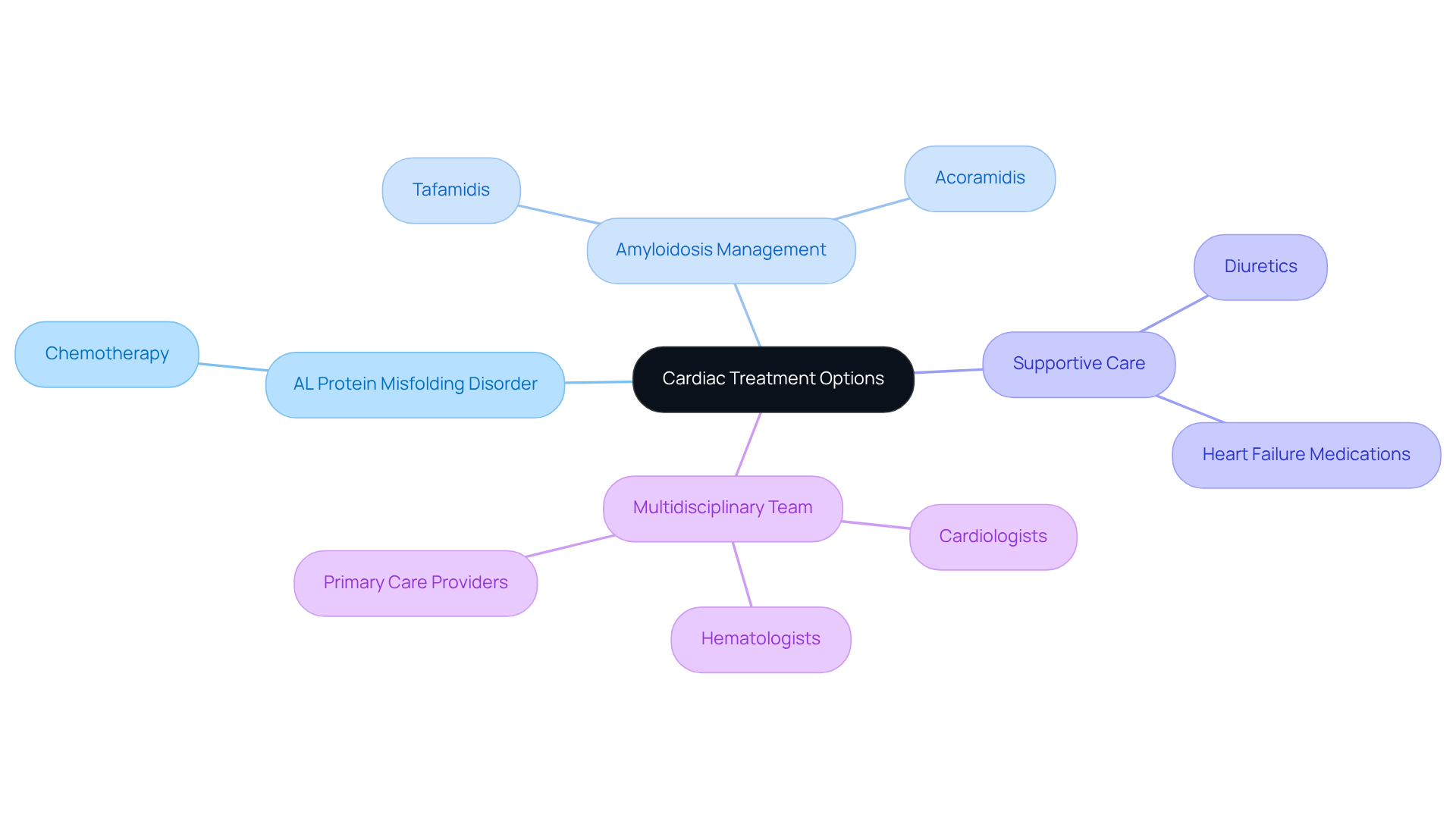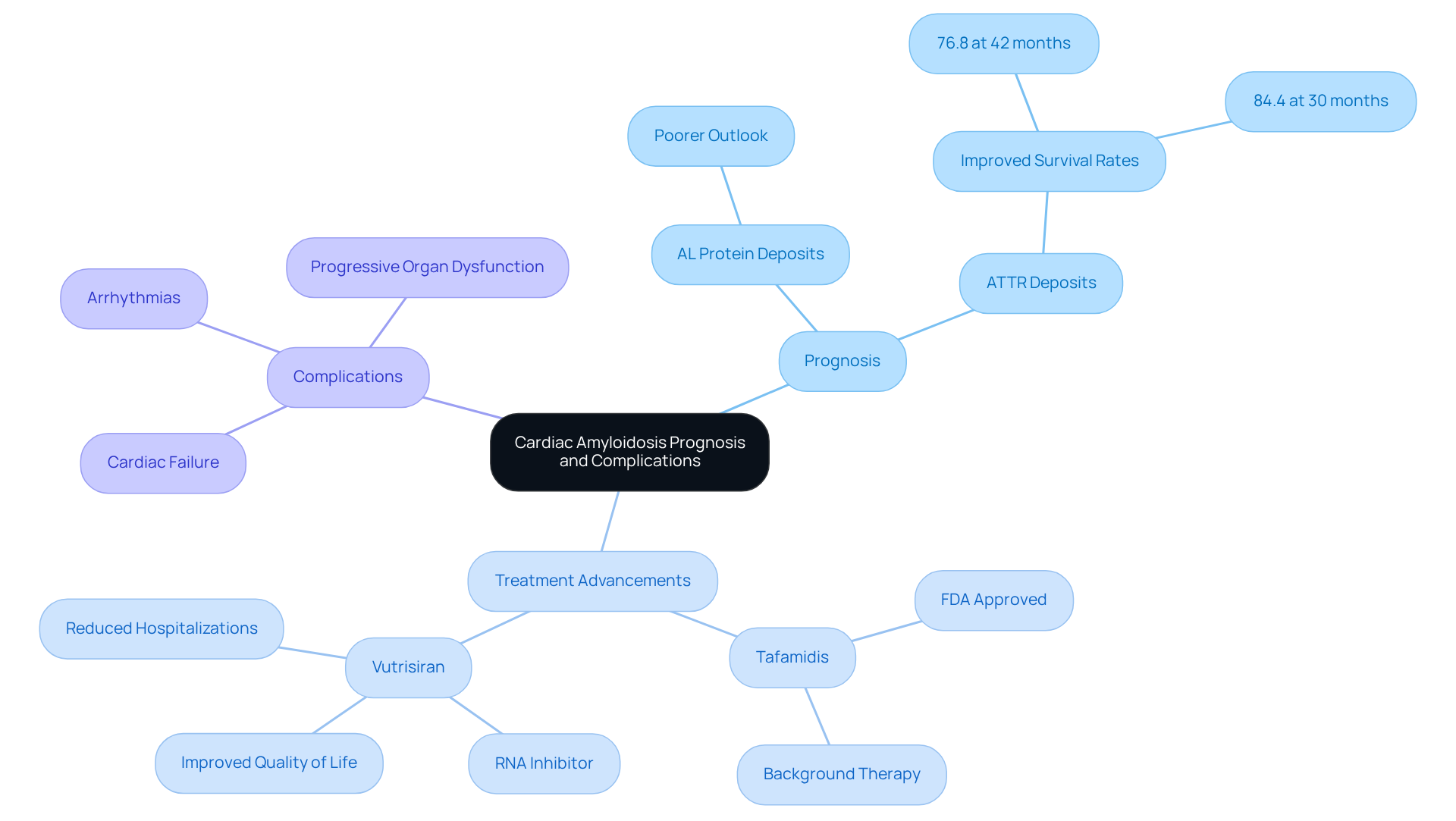


Amyloidosis of the heart is a rare but serious condition that can significantly impact your cardiovascular health. It involves an abnormal buildup of amyloid proteins in the heart tissue, which can lead to serious complications like heart failure. This makes early diagnosis and intervention incredibly important for improving outcomes.
Did you know that nearly 14% of heart failure patients might be affected by this condition? It’s understandable to feel concerned about your heart health. Recognizing the symptoms and navigating the complexities of diagnosis and treatment can be daunting. That’s why understanding cardiac amyloidosis is essential for anyone looking to protect their heart.
If you or a loved one are experiencing symptoms, don’t hesitate to reach out for support. You deserve to feel empowered and informed about your health. Remember, you’re not alone in this journey.
Amyloidosis of the heart is a rare but significant condition that involves an unusual buildup of amyloid proteins in various organs. In cases of amyloidosis of the heart, these proteins infiltrate the heart tissue, leading to thickened walls and a stiff muscle. This can severely impact the heart's ability to pump blood effectively, potentially resulting in heart failure and various cardiovascular issues.
The consequences for cardiovascular health can be profound, often leading to restrictive cardiomyopathy. This condition makes it difficult for the heart to fill properly between beats, which can cause distressing symptoms like shortness of breath, fatigue, and swelling in the legs and abdomen. Have you or a loved one experienced any of these symptoms? It's important to know that you're not alone.
Statistics reveal that nearly 14% of individuals with heart failure may have amyloidosis of the heart, particularly notable in those with preserved ejection fraction (HFpEF) and reduced ejection fraction (HFrEF). For instance, a study found that 11.3% of individuals with HFrEF had underlying amyloidosis of the heart. This highlights the need for awareness and understanding of this condition.
Cardiologists stress the importance of early diagnosis and intervention. Increased awareness and timely treatment can significantly enhance patient outcomes. As we learn more about cardiac diseases, it becomes clear that addressing amyloidosis of the heart is vital for improving heart health and enhancing overall quality of life. If you have concerns about your heart health, please reach out for support. We're here to help you navigate this journey.

Cardiac accumulation of abnormal protein can be concerning, and it often arises from various underlying conditions. The two main types are light chain accumulation (AL) and transthyretin accumulation (ATTR). AL protein misfolding is frequently linked to plasma cell disorders, while ATTR can be inherited or related to aging.
As we age, the risk of developing this condition significantly increases, particularly for AL type, where most diagnoses occur in individuals over 40. It’s important to note that men are more likely to be affected than women, and having a family history of this condition can further heighten the risk. Additionally, chronic inflammatory diseases, hypertension, and diabetes may contribute to the development of amyloidosis of the heart.
Understanding these risk factors is crucial for early detection and effective management of the disease. Timely intervention can greatly enhance outcomes for individuals. Have you or a loved one experienced any symptoms? Recent studies show that patients from socioeconomically disadvantaged backgrounds often receive diagnoses at more advanced stages. This highlights the need for increased awareness and screening in these communities.
If you have concerns about your health or that of a loved one, please don’t hesitate to reach out for support. You’re not alone in this journey, and there are resources available to help you navigate these challenges.

Diagnosing cardiac amyloidosis can feel overwhelming, but understanding the process can help ease your concerns. It involves a thoughtful approach that combines clinical evaluation, advanced imaging studies, and laboratory tests. We start with a comprehensive medical history and physical assessment, followed by blood tests to identify any abnormal proteins and biomarkers that may indicate strain on your heart.
Imaging techniques are crucial in assessing heart structure and function. Echocardiography often serves as the first-line tool, providing valuable insights. Additionally, cardiac magnetic resonance imaging (CMR) has become a powerful technique, helping to distinguish cardiac deposits from other forms of hypertrophic cardiomyopathy and offering a clearer picture of disease progression.
Recent advancements in imaging, such as bone scintigraphy using tracers like 99mTc-p5+14, have shown high sensitivity and specificity for detecting transthyretin (ATTR) protein misfolding. This non-invasive alternative to traditional biopsy methods can be a relief for many. In fact, studies indicate that nuclear scintigraphy can effectively establish a diagnosis of ATTR even when paraproteinemia is absent, which is vital for timely intervention.
While a definitive diagnosis of amyloidosis of the heart may still require a biopsy of heart tissue to confirm the presence of amyloid deposits, the incorporation of non-invasive imaging methods has significantly improved our ability to identify heart-related conditions. This means earlier detection and better outcomes for patients like you. As the field continues to evolve, remember that the combination of imaging and laboratory tests is essential for effectively managing this complex condition. If you have any concerns or questions, please don’t hesitate to reach out for support.

When it comes to treating cardiac conditions, it's important to understand that approaches can vary based on the type and severity of the disease. For those facing AL protein misfolding disorder, chemotherapy often serves as the first-line treatment, helping to reduce the production of abnormal proteins. On the other hand, amyloidosis of the heart can be managed with medications that stabilize the transthyretin protein, such as tafamidis and acoramidis, which have proven effective in slowing the progression of the disease.
Supportive care plays a crucial role as well. This includes:
Ensuring that patients receive comprehensive support. In more advanced cases, heart transplantation might be an option worth considering. It's essential to have a multidisciplinary team comprising:
Working together for optimal management.
In addition to this, Amavita's CardioElite™ program acts as a valuable resource, enhancing the treatment landscape by providing advanced, real-time diagnostic data and 24/7 cardiology consultation. The integration of AI and AHA certification within this program further promotes proactive, data-driven care, addressing the gaps in heart care at skilled nursing facilities (SNFs).
This thorough approach to cardiovascular management not only aids in treating heart conditions but also significantly reduces readmission rates by fostering proactive care. Remember, you’re not alone in this journey; support is always available to help you navigate your health concerns.

The prognosis for patients with deposits due to amyloidosis of the heart can vary quite a bit, depending on the type of deposits and when they are diagnosed. Generally, AL protein deposition disorder tends to have a poorer outlook compared to ATTR, largely due to its more aggressive nature. However, there’s good news! Over the past decade, significant advancements in treatment options for ATTR amyloidosis, like tafamidis and vutrisiran, have emerged, leading to marked improvements in survival rates.
At Amavita Heart and Vascular Health, our specialists are dedicated to using advanced diagnostic imaging and thorough evaluations to ensure early diagnosis and personalized treatment plans. This approach has shown promising results, with survival rates reaching 76.8% at 42 months, as demonstrated in the HELIOS B clinical trial. Many patients can live for years after diagnosis with the right care.
That said, it’s important to be aware of potential complications, such as:
These issues may require ongoing monitoring and management. Patients should keep an eye out for signs of worsening heart function, like increased shortness of breath or swelling. Regular follow-ups with your healthcare team, which may include echocardiograms and blood tests, are crucial for optimizing outcomes.
Our outpatient approach is designed for your convenience, allowing for same-day care without significant disruption to your life. We’re here to support you every step of the way.

Cardiac amyloidosis is a serious condition that deserves our attention, as it can profoundly affect heart health. The buildup of amyloid proteins can lead to complications like heart failure and restrictive cardiomyopathy. This highlights the importance of being aware and seeking early intervention.
As we explore this topic, it’s essential to understand the causes and risk factors associated with cardiac amyloidosis, the diagnostic procedures involved, and the treatment options available. Recognizing the different types of amyloidosis, being aware of the symptoms, and knowing about advancements in diagnostic imaging are crucial for timely diagnosis and effective management. Thankfully, recent advancements in treatment have improved the prognosis for many patients, underscoring the need for ongoing monitoring and support.
In conclusion, being aware and taking a proactive approach to managing cardiac amyloidosis can significantly improve patient outcomes. If you or a loved one are experiencing symptoms or have a family history of this condition, it’s vital to reach out to healthcare professionals for guidance. By fostering a deeper understanding of cardiac amyloidosis and encouraging timely intervention, we can navigate the path to better heart health together, with confidence and support.
What is amyloidosis and how does it affect heart health?
Amyloidosis is a rare condition characterized by the abnormal buildup of amyloid proteins in various organs, including the heart. This buildup can lead to thickened heart walls and stiff muscle, impairing the heart's ability to pump blood effectively, which may result in heart failure and other cardiovascular issues.
What are the symptoms of cardiac amyloidosis?
Symptoms of cardiac amyloidosis can include shortness of breath, fatigue, and swelling in the legs and abdomen. These symptoms arise due to restrictive cardiomyopathy, which makes it difficult for the heart to fill properly between beats.
How prevalent is amyloidosis among individuals with heart failure?
Statistics indicate that nearly 14% of individuals with heart failure may have amyloidosis of the heart. This prevalence is particularly notable in patients with preserved ejection fraction (HFpEF) and reduced ejection fraction (HFrEF), with a study showing that 11.3% of individuals with HFrEF had underlying amyloidosis.
What are the main types of cardiac amyloidosis?
The two main types of cardiac amyloidosis are light chain accumulation (AL) and transthyretin accumulation (ATTR). AL is often associated with plasma cell disorders, while ATTR can be inherited or related to aging.
What are the risk factors for developing cardiac amyloidosis?
Risk factors for developing cardiac amyloidosis include age (most diagnoses occur in individuals over 40), male gender, family history of the condition, chronic inflammatory diseases, hypertension, and diabetes.
Why is early diagnosis and intervention important for cardiac amyloidosis?
Early diagnosis and intervention are crucial as they can significantly enhance patient outcomes. Increased awareness and timely treatment can improve heart health and overall quality of life for individuals affected by this condition.
How does socioeconomic status affect the diagnosis of cardiac amyloidosis?
Recent studies suggest that patients from socioeconomically disadvantaged backgrounds often receive diagnoses at more advanced stages of cardiac amyloidosis, highlighting the need for increased awareness and screening in these communities.